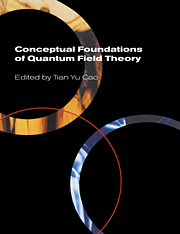Book contents
- Frontmatter
- Contents
- List of contributors
- Preface
- Photographs of the conference
- Introduction: Conceptual issues in quantum field theory
- Part One Philosophers' interest in quantum field theory
- 1 Why are we philosophers interested in quantum field theory?
- 2 Quantum field theory and the philosopher
- Part Two Three approaches to the foundations of quantum field theory
- Part Three
- Part Four Mathematics, statistics and quantum field theory
- Part Five Quantum field theory and space-time
- Part Six
- Part Seven Renormalization group
- Part Eight Non-Abelian gauge theory
- Part Nine The ontology of particles or fields
- Part Ten
- Name index
- Subject index
1 - Why are we philosophers interested in quantum field theory?
Published online by Cambridge University Press: 22 September 2009
- Frontmatter
- Contents
- List of contributors
- Preface
- Photographs of the conference
- Introduction: Conceptual issues in quantum field theory
- Part One Philosophers' interest in quantum field theory
- 1 Why are we philosophers interested in quantum field theory?
- 2 Quantum field theory and the philosopher
- Part Two Three approaches to the foundations of quantum field theory
- Part Three
- Part Four Mathematics, statistics and quantum field theory
- Part Five Quantum field theory and space-time
- Part Six
- Part Seven Renormalization group
- Part Eight Non-Abelian gauge theory
- Part Nine The ontology of particles or fields
- Part Ten
- Name index
- Subject index
Summary
This two-tier conference signals a new phase of philosophers' interest in quantum field theory, which has been growing noticeably in the last few years. However, some prominent physicists have shown their deep suspicions against ignorant philosophers' intrusion into their profession, and have expressed their hostility quite openly. In the philosophy community, some prominent philosophers of physics have also expressed their suspicions against the rationale of moving away from the profound foundational problems raised by Einstein and Bohr, Bohm and Bell, such as those concerning the nature of space-time and measurement, possibility and implications of hidden variables and nonlocality, and stepping into the technical complexity of quantum field theory, which is only an application of quantum mechanics in general without intrinsically distinct philosophical questions to be explored. In order to dispel these suspicions, it is desirable to highlight certain aspects of quantum field theory which require philosophical reflections and deserve further investigations. This discussion intends to suggest that philosophers can learn many important lessons from quantum field theory, and may be of some help in clarifying its conceptual foundations. At this stage of crisis that quantum field theory is experiencing now, the clarification may contribute to the radical transformation of our basic concepts in theoretical physics, which is necessary for a happy resolution of the crisis and the emergence of a new promising fundamental physical theory.
Generally speaking, philosophers are interested in the metaphysical assumptions adopted by science and the world picture suggested by science.
- Type
- Chapter
- Information
- Conceptual Foundations of Quantum Field Theory , pp. 28 - 33Publisher: Cambridge University PressPrint publication year: 1999
- 3
- Cited by



